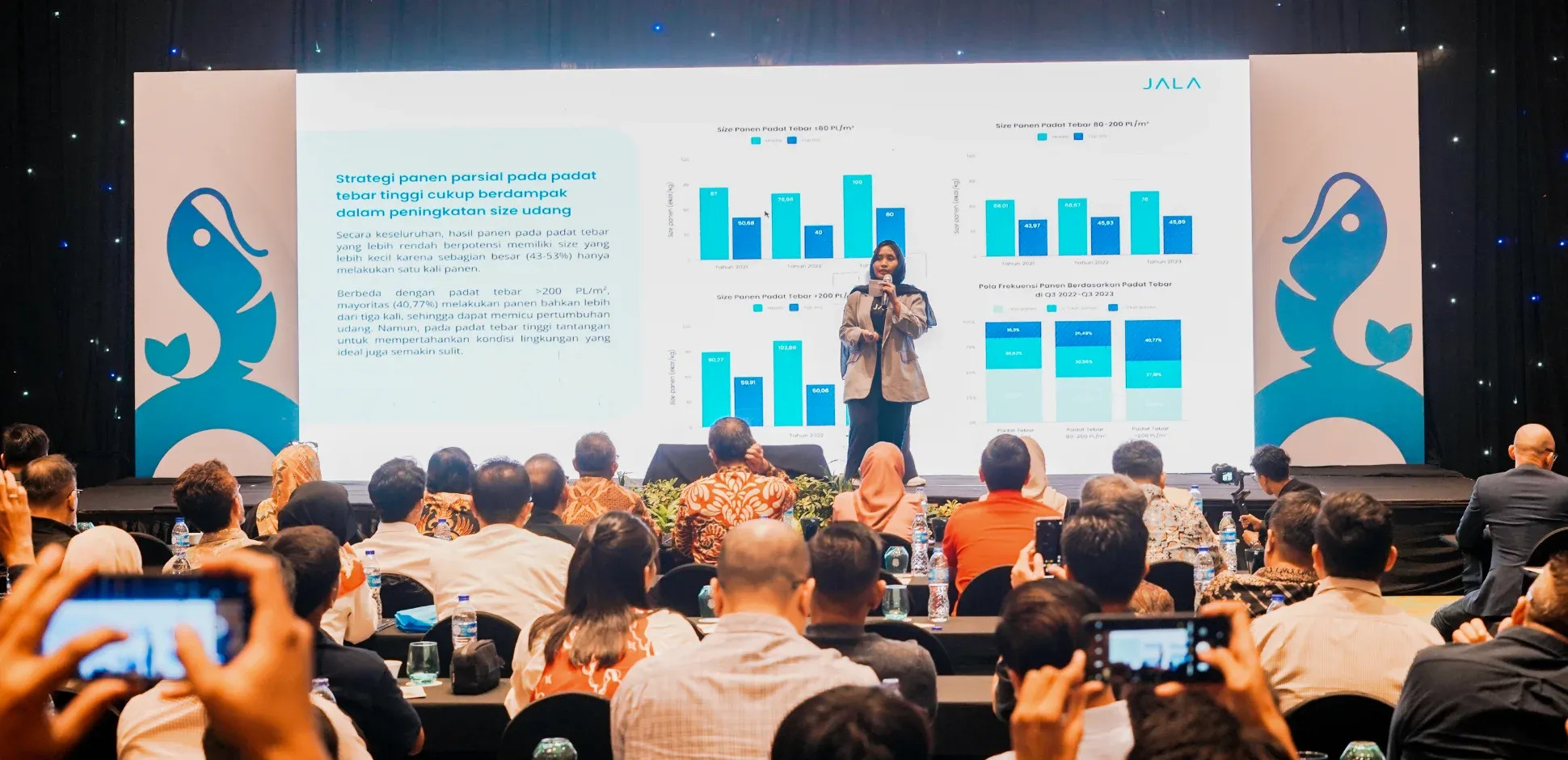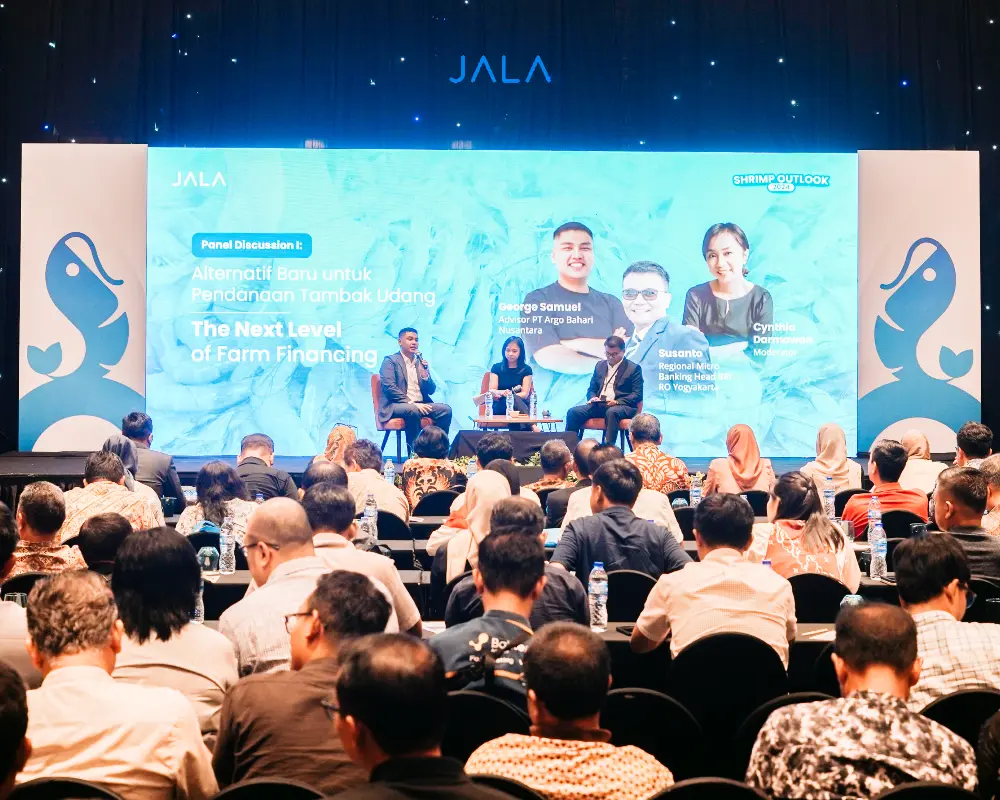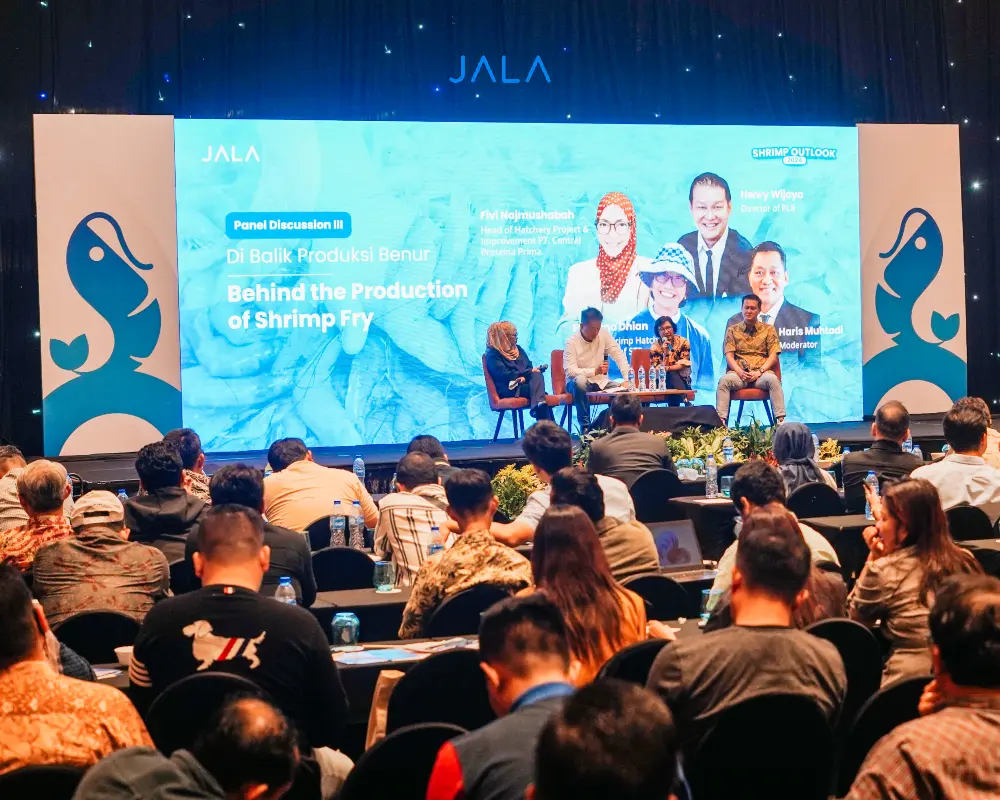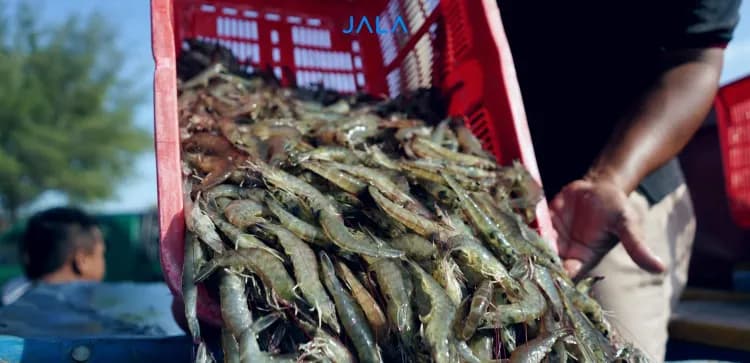
JALA, an aquaculture technology company providing end-to-end shrimp farming solutions in Indonesia, held the Shrimp Outlook 2024 event in Fairfield by Marriott, Surabaya. With 339 attendees with diverse backgrounds, from shrimp farmers, processing companies, aquaculture industry stakeholders, as well as fry and feed producers, this event discusses Indonesia’s latest shrimp cultivation performance and outlined takeaways for improved productivity in 2024.
Erwin Dwiyana, Marketing Director of the Director General of Strengthening the Competitiveness of Marine and Fishery Product of Indonesia’s Ministry of Maritime Affairs and Fisheries, in his opening remarks, highlighted the significance of the event amidst ongoing developments in the shrimp industry. Meanwhile, Aryo Wiryawan as Chairman of JALA in his opening remarks addressed the importance of collaboration to thrive in the global market. Haris Muhtadi, Chairman of the Shrimp Club Indonesia (SCI), conveyed that the condition of the shrimp industry in Indonesia may not be favorable, but it is the challenges faced that make industry participants more united and cohesive.
Indonesian shrimp industry report throughout 2023
During the main session, Liris Maduningtyas, co-founder and CEO of JALA, delivered an in-depth exposition about the evaluation of Indonesia’s shrimp industry performance in 2023 and insights for 2024. She stated, “The average productivity of shrimp farms is 12 tons/ha. To aim for better profitability, farmers are advised to cultivate shrimp for 70-80 days or 100-110 days.”
Liris also emphasized the need to enhance local market absorption. This is crucial to safeguard local shrimp prices from significant fluctuations when the export market becomes unstable. Any efforts to increase production this year should go hand-in-hand with environmental control and data recording.
Discussing new funding alternatives for shrimp farms
Shrimp Outlook 2024 also discussed strategies to obtain funding for farmers through the first panel discussion, “The Next Level of Farm Financing”. This session explored innovative financing mechanisms for shrimp farmers to propel their business.

This discussion featured George Samuel as the Advisor of PT Agro Bahari Nusantara Tbk (UDNG) and Susanto of BRI, moderated by Cynthia Darmawan. George and Susanto discussed the importance of regular data recording and creating financial reports for farmers who want to apply for bank or equity funding. Moreover, farmers are encouraged to be actively engaged in the continuous learning and decision-making processes in their own farm.
Raising hope for shrimp market conditions in 2024
One of the greatest challenges for Indonesia’s shrimp industry is the impact of the fluctuating global market. The second panel discussion emphasized strategies in navigating the volatile global market dynamics through the theme, “Bouncing Back Stronger on the 2024 Shrimp Market”, featuring Gunawan Mulyono of AP5I and Ricky Leonardo of TreeDots, moderated by Lois Darminto.
Delving into current shrimp market conditions, there is currently an oversupply of shrimp in the global market and increasing competition from countries such as Ecuador and China. Efforts to increase the competitiveness of Indonesia’s shrimp includes providing value-added and cooked shrimp products to achieve better selling prices.
Solutions for shrimp health and cultivation efficiency
GreenSage Prebiotics from Canada also had the opportunity to share about their novel innovation to promote shrimp health from within. Introducing Pretego, their latest product, Selva Kumar, the VP of Engineering, explained how this upcycled copra product supports shrimp growth and survival as well as the growth of beneficial bacteria in aquaculture. This helps farmers to significantly reduce costs in their cultivation and increases the SR of their shrimp.
The next sponsor for this event, Minnowtech, an aquaculture technology company based in Baltimore, Maryland, also presented their solution. Suzan Shahrestani, the co-founder, highlighted Minnowtech’s latest innovation in calculating shrimp biomass through sonar technology with more than 95% accuracy. Their solution has now been leveraged to monitor more than 1.3 billion shrimp globally.
Diving deeper into shrimp fry production with experts
As hatcheries play a pivotal role in the current shrimp production landscape, the third panel discussion raised an exchange of perspectives with the theme, “Behind the Production of Shrimp Fry”. Shrimp fry industry players Emiliana Dhian of PT Suri Tani Pemuka, Fivi Najmushabah of PT Central Pertiwi Bahari, and Henry Wijaya of Prima Larvae Bali took the stage and discussed how to overcome hurdles in fry production, moderated by Haris Muhtadi of SCI.

Hatcheries are promptly responding to the outbreak of various shrimp diseases, continuously making improvements such as strict screening and biosecurity measures as part of their disease control procedure. Hatcheries also ensure the use of quality live feed high in EPA and DHA to produce high quality fry. All of these efforts ensure that hatcheries deliver fry of the best quality for farmers to cultivate.
JALA is #HeretoHelp shrimp farmers
Shrimp Outlook 2024 also introduces JALA’s solutions tailored to tackle various problems in the shrimp industry. JALA App, a shrimp farm management software platform, allows farmers to monitor pond conditions and carry out cultivation management with data-driven decision-making. JALA’s multiparameter water quality measurement device, JALA Baruno, significantly reduces the complexity associated with water quality measurement and monitoring. Apart from cultivation technology, JALA also provides support in the form of cultivation supplies and assistance as well as access to market and funding. JALA’s end-to-end solutions underscore their dedication to supporting every facet of the shrimp farming journey.
Enthusiasm and hope after Shrimp Outlook
Jacky, a newly established shrimp farmer attending this event, expressed his enthusiasm toward the panel discussion’s topics. “The panel discussion about the next level of farm financing is very inspirative, providing detailed insights for us who are about to dive into this industry,” he said.
A great enthusiasm was also expressed by another attendee, Haviel, who was fascinated by JALA's Shrimp Outlook report. “I think the Shrimp Outlook presentation session was very interesting since it discussed the ups and downs of the shrimp industry last year,” he remarked.
As the second installment to JALA’s annual event, Shrimp Outlook 2024 serves as the occasion to reflect shrimp farming performance in last year and plan for the ongoing year. Although the shrimp industry is currently faced with various issues such as decreased productivity and volatile shrimp prices, farmers are encouraged to keep cultivating with proper data recording. This not only helps them stay updated with their cultivation performance to take the best step, but also assists in applying for farm financing.
In light of reducing the reliance on the export market, every party involved in the shrimp industry should make an effort to increase the absorption of shrimp in the local market. As shrimp disease remains a threat to watch out for, both hatcheries and farmers alike should be prepared by strict biosecurity measures in every aspect of their business. Hopefully, the series of insights shared can serve as an enlightenment and bring new optimism for everyone in the shrimp industry.





